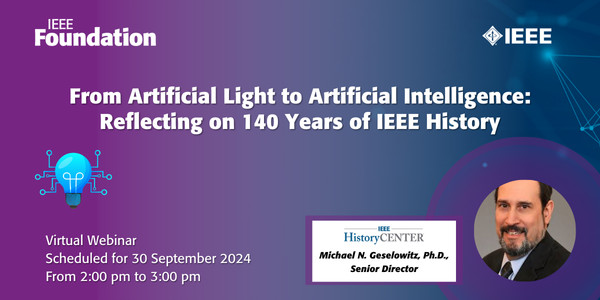Looking to submit your own event? Submit your information via the Events Submission page.
Calendar of Events
|
Monday
|
Tuesday
|
Wednesday
|
Thursday
|
Friday
|
Saturday
|
Sunday
|
|---|---|---|---|---|---|---|
|
0 events,
|
0 events,
|
0 events,
|
0 events,
|
0 events,
|
0 events,
|
0 events,
|
|
0 events,
|
0 events,
|
0 events,
|
0 events,
|
0 events,
|
0 events,
|
0 events,
|
|
0 events,
|
0 events,
|
0 events,
|
0 events,
|
0 events,
|
0 events,
|
0 events,
|
|
0 events,
|
0 events,
|
0 events,
|
0 events,
|
0 events,
|
0 events,
|
0 events,
|
|
0 events,
|
0 events,
|
0 events,
|
0 events,
|
0 events,
|
0 events,
|
0 events,
|
|
1 event,
Virtual Event

Virtual Event
Join the IEEE History Center and the IEEE Foundation on a historical journey, "From Artificial Light to Artificial Intelligence: Reflecting on 140 Years of IEEE History." Let's celebrate together as the History Center launches IEEE History Week in October (link to the page here) and as we commemorate IEEE Day along with the IEEE 140th Anniversary observed all this year! These events mark significant milestones in our history, and we are proud to honor them with a wonderful historical lecture. The keynote speaker, Michael Geselowitz, Ph.D., Sr. Director of the IEEE History Center, will share his unique insights and walk you through the remarkable history from 1884 to the present day, the celebration of 125-anniversary milestones, and the 140th anniversary in 2024. We shall see how IEEE has hit some significant moments throughout its long, vibrant history—through the years and more. |
0 events,
|
0 events,
|
1 event,
-

In October 1880, Thomas A. Edison published “The Success of the Electric Light,” in The North American Review,” to explain that the adoption of his electric light for domestic use has been delayed “due to the enormous mass of details which have to be mastered before the system can go into operation on a large scale, and on a commercial basis as a rival of the existing system of lighting by gas.” The “enormous mass of details” would include further research and development to improve the lamp, founding companies to manufacture components, and personally funding and supervising a company to build power plants. This talk will focus on the Thomas A. Edison Central Station Construction Department, a little-known entity founded by Edison himself in May 1883, to construct direct-current electric power stations in towns and cities throughout the United States. It built thirteen central stations in Massachusetts, New York, Ohio, and Pennsylvania before being absorbed by the Edison Company for Isolated Lighting in October 1884, coincidently, around the time IEEE was founded. While Edison stepped away from the day-to-day central station business, he continued research in direct current and later alternating current technology. And by the late 1880s, he found himself dragged into a media war with George Westinghouse in what has become the mythical “battle of the currents.” In 1887, Edison opened a new and expanded research laboratory in West Orange, New Jersey and by 1890 his research and business interests moved on to the improved phonograph, the talking doll, motion pictures, ore milling, and other technologies. |
0 events,
|
0 events,
|
0 events,
|
